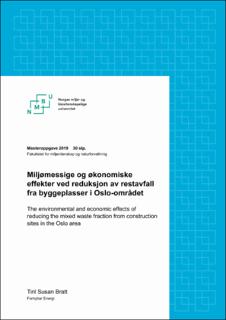| dc.contributor.advisor | Hanssen, Ole Jørgen | |
| dc.contributor.advisor | Frydenlund, Jørn | |
| dc.contributor.author | Bratt, Tiril Susan | |
| dc.coverage.spatial | Norway, Oslo | en_US |
| dc.date.accessioned | 2020-02-19T09:35:56Z | |
| dc.date.available | 2020-02-19T09:35:56Z | |
| dc.date.issued | 2019 | |
| dc.identifier.uri | https://hdl.handle.net/11250/2642483 | |
| dc.description.abstract | I 2017 sto bygg- og anleggsbransjen i Norge for 25% av den nasjonale avfallsgenereringen, men kun 34% av dette ble sendt til materialgjenvinning. For å nå EUs mål om 70% materialgjenvinning av dette avfallet, er det behov for bedre håndtering. Formålet med oppgaven har derfor vært å undersøke historisk og fremtidig avfallsgenerering i byggebransjen i Oslo-området, samt avdekke ulike motivasjonsfaktorer som bidrar til endret håndtering ute på byggeplass. I tillegg ble livsløps- og livssykluskostnadsanalyse tatt i bruk for å analysere miljømessige og økonomiske effekter ved ytterligere utsortering av restavfallet.
For å få til en ytterligere utsortering av rene fraksjoner i restavfallet, er det avgjørende at man har et avfallsfokus helt fra planleggingsfasen. Tidligere forskning viser til tanker om at avfall er uunngåelig, og at avfallshåndtering derfor blir nedprioritert. Flere informanter fra dybdeintervjuene understreker videre at den generelle holdningen i bransjen har endret seg, men adferden henger fortsatt noe igjen i gamle vaner.
Resultatene i denne oppgaven indikerer derimot en nedadgående trend i både den totale avfallsgenereringen, restavfallsmengden og sorteringsgraden i byggeprosjekter i Oslo-området frem mot 2030. Framskrivingene bærer preg av noe usikkerhet, men trendens utvikling kan likevel indikere en endring i avfallshåndtering på byggeplasser. I tillegg indikerer resultatene, under de gitte forutsetningene, at det kan være en klimabesparelse på 3 tonn CO2-eq per år og en reduksjon i livssykluskostnader på 23,3% dersom det foreligger en ytterligere utsortering av de rene fraksjonene trevirke, plast, papp og papir fra restavfallet. Det er likevel anbefalt med videre undersøkelse av utvalgte variabler som påvirker resultatet i stor grad, for å gjøre funnene i oppgaven mer generaliserbare. | en_US |
| dc.description.abstract | In 2017 the Norwegian building and construction industry accounted for 25% of the total waste generation in Norway, however, only 34% was recycled. To be able to reach the EU’s recovery target of 70% recycling of construction and demolition waste (CDW), it requires a better overall waste management. The purpose of the thesis has been to investigate historical and future amount of CWD in the Oslo area, and to reveal key motivators to change the waste management in the construction industry. Furthermore, a life cycle analysis and a life cycle cost analysis were conducted to assess the environmental and economic effects by further reduction of the mixed waste fraction.
To reach a higher recycling percentage during a construction project, it is important to include the waste management from the very beginning. Previous studies indicate that people in the building and construction industry believe that waste is unavoidable, which results in waste management receiving less attention. Several people that were interviewed, emphasized that the general attitude in the construction industry has changed, but the behavior still lingers somewhat in old habits.
In this study, the results indicate that the total waste generation, the amount of the mixed waste fraction, and the recycling percentage on construction sites in the Oslo area have a declining trend towards 2030. The projections are somewhat uncertain, but the evolution of the trends may indicate a certain change in the waste management. Based on various assumptions, the results indicate an annual reduction of 3 tons of CO2-eq, and a 23.3% reduction in life cycle costs, given a further reduction in the amount of wood, plastic, cardboard and paper that occur in the mixed waste fraction. However, further investigation of some of the variables are recommended to increase the validity of the study. | en_US |
| dc.language.iso | nob | en_US |
| dc.publisher | Norwegian University of Life Sciences, Ås | en_US |
| dc.rights | Attribution-NonCommercial-NoDerivatives 4.0 Internasjonal | * |
| dc.rights | Attribution-NonCommercial-NoDerivatives 4.0 Internasjonal | * |
| dc.rights.uri | http://creativecommons.org/licenses/by-nc-nd/4.0/deed.no | * |
| dc.subject | Byggavfall | en_US |
| dc.subject | Restavfall | en_US |
| dc.subject | Avfallshåndtering | en_US |
| dc.subject | Avfallsminimering | en_US |
| dc.subject | Livsløpsanalyse | en_US |
| dc.subject | Livssykluskostnader | en_US |
| dc.subject | Sorteringsgrad | en_US |
| dc.subject | Materialgjenvinning | en_US |
| dc.subject | Byggebransjen | en_US |
| dc.subject | Bygg- og anleggsbransjen | en_US |
| dc.title | Miljømessige og økonomiske effekter ved reduksjon av restavfall fra byggeplasser i Oslo-området | en_US |
| dc.title.alternative | The environmental and economic effects of reducing the mixed waste fraction from construction sites in the Oslo area | en_US |
| dc.type | Master thesis | en_US |
| dc.description.version | submittedVersion | en_US |
| dc.source.pagenumber | 99 | en_US |
| dc.description.localcode | M-FORNY | en_US |

